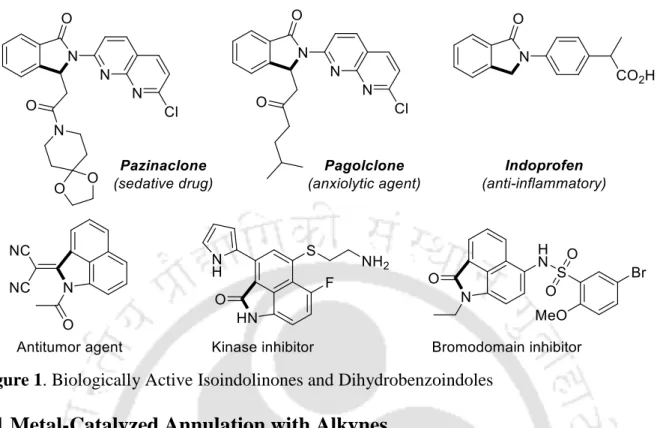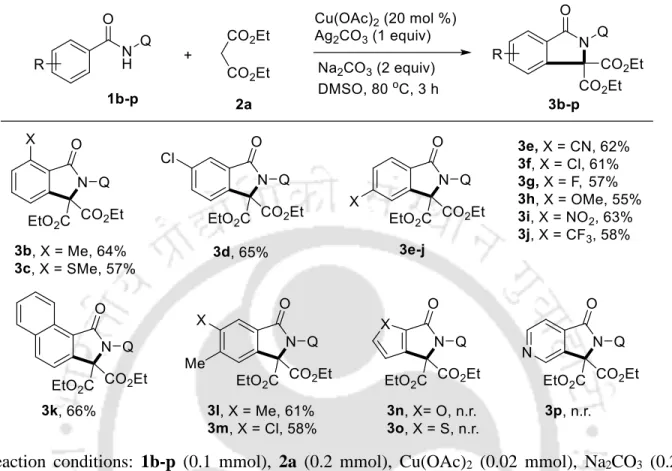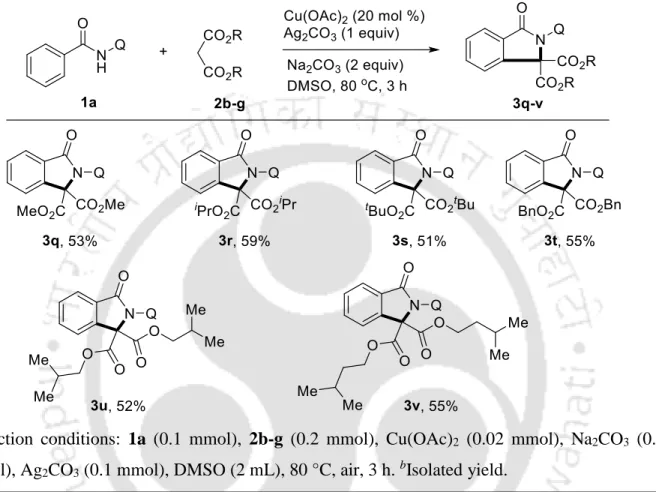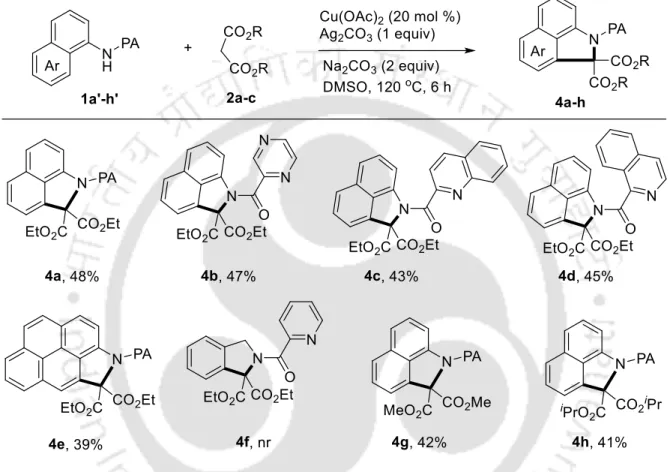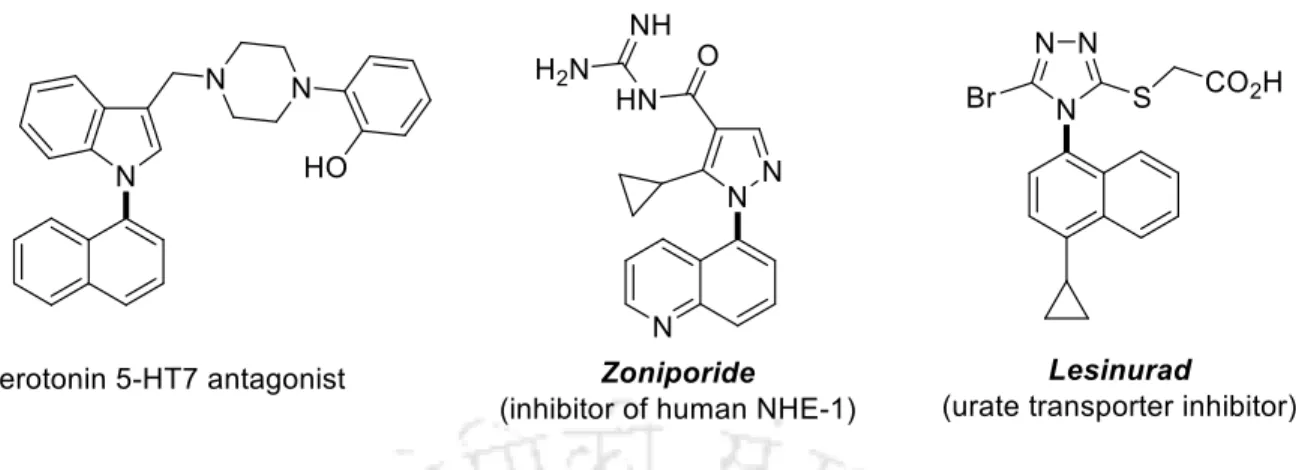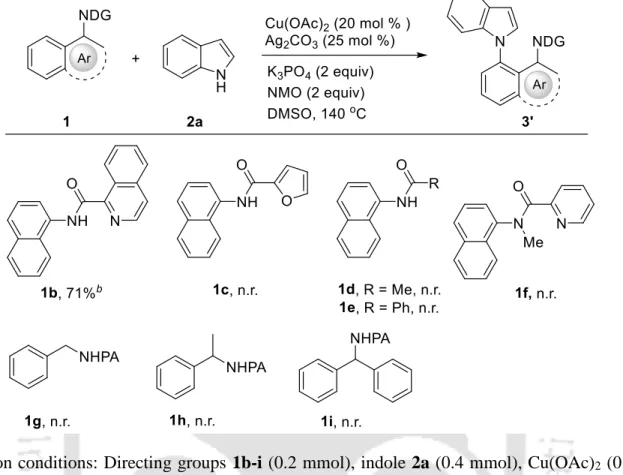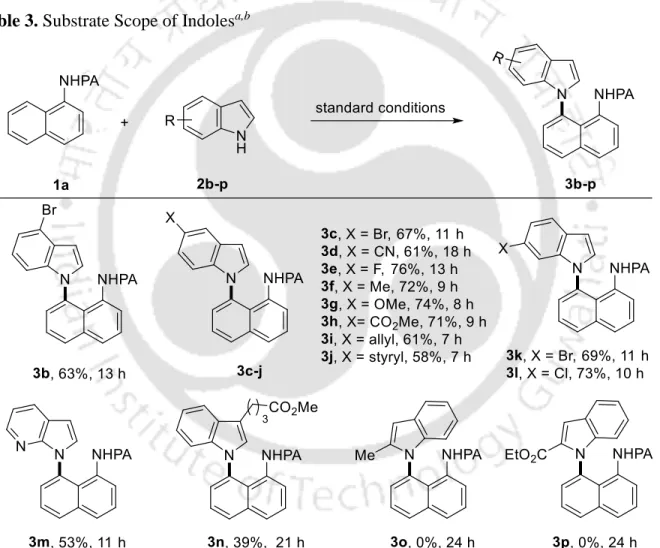Moholkar, Department of Chemical Engineering for their valuable suggestions and comments during all reviews throughout the period of my thesis. Prabhat Kumar Maharana for their moral support and invaluable encouragement whenever I approached them and for their friendly relationship.
Rh(III)-Catalyzed C4-Allylation of Indoles with MBH Adducts
Indoles with versatile functional groups are well tolerated to give the target products in good yields and late stage modification of the natural products has also been achieved.
Rh(III)-Catalyzed Switchable C4-Alkenylation and Alkylation of Indoles with Allylic Alcohols
Rh(III)-Catalyzed C4-Alkenylation vs Alkylation of Indoles with Allylic Alcohols
Metal-catalyzed cancellation with alkynes Electro-oxidative cancellation with alkynes Metal-catalyzed cancellation with maleimides Metal-catalyzed cancellation with alkenes.
Cu(II)-Mediated N-Arylation of Azoles through Dehydrogenative Cross- Coupling
Rh(III)-Catalyzed C4-Selective Allylation of Indoles Exploiting MBH Adducts
Cu(II)-Catalyzed Oxidative C-H/N-H Annulation of Benzamides with Dialkyl Malonates
Metal-Catalyzed Annulation with Alkynes
Zhang and colleagues reported a co-catalyzed oxidative cancellation of terminal alkynes with aromatic amides using 8-aminoquinoline as a bidentate adjuvant using Ag2CO3 as a stoichiometric oxidant to access a variety of isoindolinones (Scheme 1). 9 The method has been extended to aliphatic amides to yield pyrrolidinos and tolerates a wide variety of functional groups.
Co(II)-Catalyzed Oxidative Annulation of Benzamides
Ni(II)-Catalyzed C-C/C-N Annulation of Benzamides
- Electro-Oxidative Annulation with Alkynes
Electrochemical Oxidative Annulation of Benzamides
- Metal-Catalyzed Annulation with Maleimides
Annulative Coupling of Maleimides under Co(II)-Catalysis
- Metal-Catalyzed Annulation with Alkenes
Co(II)-Catalyzed C-H/N-H Functionalization with Alkenes
- Metal-Catalyzed Alkylation/Annulation with C(sp 3 )-H Bonds
Cu(II)-Catalyzed Oxidative Annulation with Malonates
Pd(II)-Catalyzed Coupling of β-Keto Esters with Anilides
Cu-Promoted Synthesis of Isoquinolinone
Pd(II)-Catalyzed Dehydrogenative Coupling with β-Keto Esters
Cu-Promoted Annulation of Benzamides with Nitroalkanes
A double metal-catalyzed oxidative C–H/N–H annulation of benzamides with Co(II)/Cu(II)-based substituted aliphatic ketones was developed using the 8-aminoquinoline moiety as a bidentate directing group (Scheme 12).20 tandem protocol shows a broad tolerance of functional groups with aromatic amides as well as with ketones. Structurally diverse biologically important isoindolin-1-ones were synthesized by the reaction of substituted benzamides with ketones.
Co(II)/Cu(II)-Catalyzed Oxidative Annulation with Ketones
- Present Study
Then, the scope of the method was extended to the oxidative coupling of substituted dialkyl malonates 2b-g with benzamide 1a as a standard substrate (Table 3). Initial N-coupling of substrate 1 with Cu(OAc)2 in the presence of base can give A, which can undergo malonate nucleophile substitution to give copper(II) intermediate B (Scheme 15).
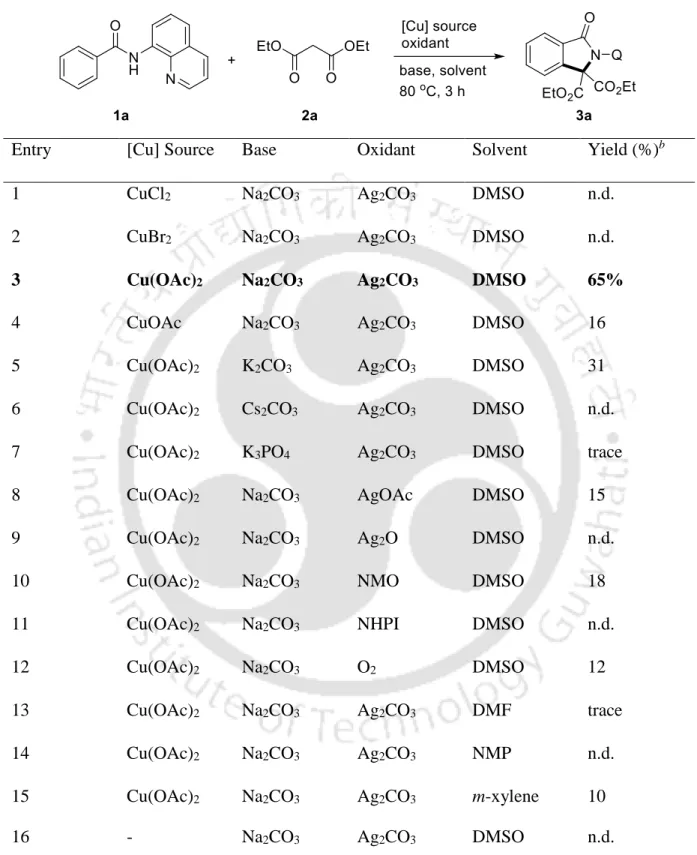
Preliminary Mechanistic Investigations
This result suggests that C−H bond cleavage may not be involved in the rate-limiting step.7a Based on preliminary mechanistic investigation and literature,7 a plausible catalytic cycle is depicted in Scheme 14. The threatened Cu species oxidized7 to copper(II) ) using Ag2CO3 to complete the catalytic cycle.
Kinetic Isotope Experiment
Proposed Catalytic Cycle
- Experimental Section
- References
- Selected NMR Spectra
- Metal-Catalyzed Amination with Prefunctionalized Amines
Drying (Na2SO4) and evaporation of the solvent gave a residue which was purified on a silica gel column chromatography with ethyl acetate and hexane as an eluent. Purification by a silica gel column chromatography with ethyl acetate/hexane as the eluent afforded the target product 4 .
![Figure S2. ORTEP diagram of diisopropyl 1-picolinoylbenzo[cd]indole-2,2(1H)-dicarboxylate 4h with 50% ellipsoid (CCDC 1981569)](https://thumb-ap.123doks.com/thumbv2/azpdfnet/10341770.0/41.918.161.783.315.789/figure-ortep-diagram-diisopropyl-picolinoylbenzo-indole-dicarboxylate-ellipsoid.webp)
Fe-Catalyzed ortho-Amination of Carboxamides
- Metal-Catalyzed Cross-Dehydrogenative Amination
Nakamura and co-workers reported the Fe(III)/diphosphine ligand F-dppbz catalyzed amination of benzamides using 8-quinolinylamide as the directing group with N-chloroamines in the presence of an organometallic base (Scheme 1).12 Various chloroamines participated in the reaction to give derivs of anthranilic acid in high yields. Daugulis and co-workers developed a removable 8-aminoquinoline assisted amination of the -C(sp2)-H bond of benzoic acid derivatives using a Cu(II)-catalyst in combination with Ag2CO3 as a co-catalyst, using the N-solvent methyl-2-pyrrolidone (NMP ) and N-methylmorpholine-N-oxide (NMO) as the oxidant (Scheme 3).14 The reaction shows high generality, tolerance for functional groups and provides a simple route to the ortho-aminobenzoic acid deriv.
Cu-Catalyzed Amination of 8-Aminoquinolinamides
Ru-Catalyzed Dehydrogenative Amination with Carbazoles
Pd-Catalyzed C8-H Amination of 1-Naphthylamides
Picolinamide Directed ortho-Amination of Anilines
Co-Catalyzed Cross-Dehydrogenative Amination of Arylamides
Amination of N-(Quinolin-8-yl)benzamides using Ni-Catalysis
Cu-Mediated Dehydrogenative Amination using NH-Heterocycles
- Electrochemical Cross-Dehydrogenative Amination
Electrochemical Co-Catalyzed Dehydrogenative Amination
- Present Study
Subsequent screening of the copper sources led to an increase to 95% conversion using Cu(OAc)2, while other copper sources, such as CuBr2, CuO and CuI, gave inferior results (items 2-5). DMSO appeared to be the solvent of choice, while DMF and NMP produced a trace of the product (entries 11-12). Subsequently, to assess the utility of the method, the scope of the procedure was explored using N-(naphthalen-1-yl)picolinamide 1a with substituted indoles 2b-p (Table 3).
We further extended the scope of the reaction using various azoles with naphthalenyl picolamide 1a (Table 5).
Proposed Reaction Mechanism
The latter can undergo oxidation to form copper(III) intermediate C, which can lead to accumulation of naphthyl C()-H to produce organocopper(III) D.23 Reductive elimination of D can give N-naphthyl azoles 3 and copper(I) species that can be oxidized to copper(II) by NMO to complete the catalytic cycle. The presence of Ag2CO3 can facilitate the formation of Cu(III) type D by accelerating the ligand substitution process with NH-heterocycles. 19, 23d-f The proposed reaction pathway also explains the need for an excess of base and oxidant to realize products in good yields. . Finally, to reveal the synthetic applicability of the protocol, removal of the directing group was performed (Scheme 13).
The product 3a was treated with NaOH in EtOH for 6 hours to give the 8-(1H-indol-1-yl)naphthalene-1-amine in 91% yield, suggesting that the products can be converted to -azole - naphthylamines.
Removal of the PA Auxiliary
- Experimental Section
- References
- Selected NMR Spectra
After an appropriate time, the resulting solution was diluted with ethyl acetate (3 x 10 mL) and then washed with brine (2 x 5 mL) and water (1 x 5 mL). Drying (Na 2 SO 4 ) and evaporation of the solvent gave a residue which was purified on silica gel column chromatography using n-hexane and ethyl acetate as eluent to give analytically pure substituted N-arylated azoles. The resulting solution was then diluted with ethyl acetate (3 x 10 mL) and washed with brine (2 x 5 mL) and water (5 mL).
Drying (Na 2 SO 4 ) and evaporation of the solvent gave a residue which was purified on silica column chromatography using n-hexane and ethyl acetate as eluent to give 3a and a mixture of unreacted 1a and 1a-d as a white solid.
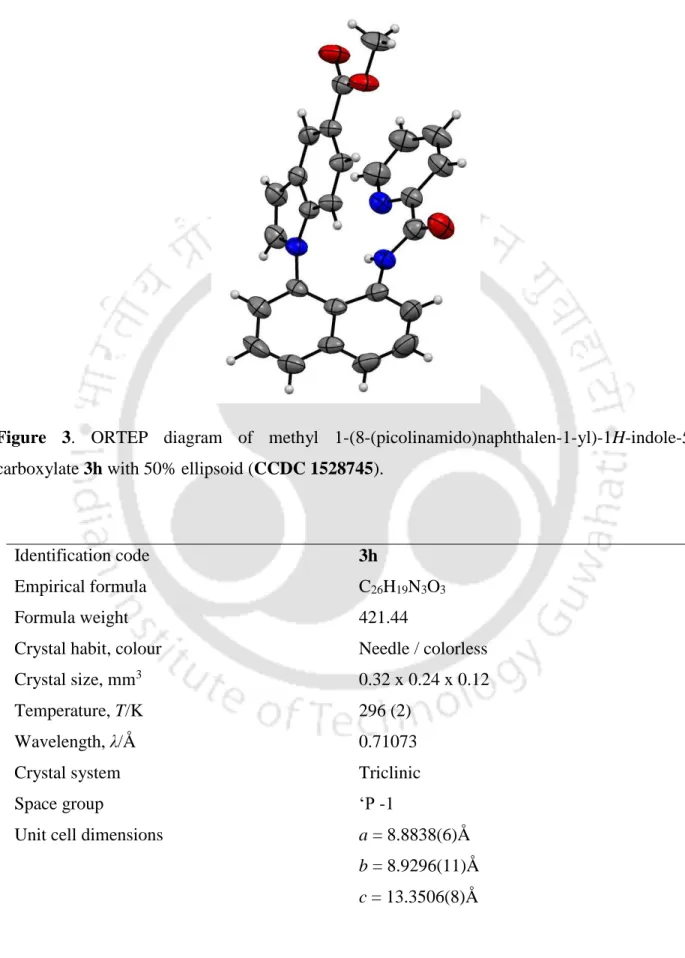
Rh(III)-Catalyzed C4-Selective Allylation of Indoles Exploiting MBH Adducts
Challenges and Developments of C4-Functionalization of Indoles
- Allylation of Arenes
- Rh-Catalyzed Reactions
Glorius and co-workers reported a Rh(III)-catalyzed oxidative C-H allylation of arenes with readily available allyl carbonates (Scheme 2).18 This expedient method provides a facile route to the allylation of electron-neutral arenes with exclusive γ-selectivity, high isomer ratio and excellent functional group compatibility.
Rh-Catalyzed ortho-Allylation of Arenes
Ma and co-workers reported a potential approach to the Rh(III)-catalyzed allylation of N-methoxybenzamides with 1,1-disubstituted or internal allenes as allyl sources (Scheme 3).19 The reaction was compatible with both electron-rich and -poor benzamides and was extended to naphthylamides and benzofuran deriv.
Rh-Catalyzed Allylation of Benzamides with Allenes
Rh-Catalyzed Annulation with MBH adducts 3.1.2 Co-Catalyzed Reactions
Co-Catalyzed Direct C-H Allylation of Arenes
Late-Stage Allylation of Peptides under Co-Catalysis 3.1.3 Ru-Catalyzed Reactions
Ru-Catalyzed Allylation of Benzoic Acids
- Pd-Catalyzed Reactions
Shi and colleagues described a Pd(II)-catalyzed atropselective C-H allylation of biarylaldehydes with tert-leucine as an efficient catalytic chiral transient adjuvant using MBH adducts as an allylation source (Scheme 8).24 A wide variety of enriched biarylaldehydes have been synthesized with functional group diversity and excellent enantioselectivity via β‐O elimination.
Pd-Catalyzed Atropselective Allylation of Aldehydes 3.1.5 Mn-Catalyzed Reactions
Mn-Catalyzed Late-Stage C-H Allylation of Peptides 3.1.6 Fe-Catalyzed Reactions
Fe-Catalyzed ortho-Allylation of Pyrazoles 3.1.7 Ni-Catalyzed Reactions
Ni-Catalyzed ortho-Allylation of Quinolinamides 3.1.8 Cu-Catalyzed Reactions
Cu-Catalyzed Direct Allylation of Polyfluoroarenes
- Present Study
Further screening of the solvents revealed that (CH2Cl)2 is the solvent of choice, providing 3a in 73% yield, while solvents such as 1,4-dioxane, PhCl, and toluene gave inferior results (entries 2-5 ). No allylation was observed in the absence of the catalyst and the starting material was recovered intact (entry 15). The electronic nature of the coordinating groups is therefore crucial to bring about successful allylation.
With the optimized reaction conditions, the scope of the method was investigated using variously substituted indoles 1b-q with MBH-adduct 2a as a standard substrate (Table 2).
Screening of Directing Groups Table 2. Substrate Scope of Indoles a,b
These results illustrate the accelerated potential of the method for late-stage modification of natural products. In the absence of the [Cp*Rh(CH3CN)3](SbF6)2 catalyst, no H/D exchange was detected at both the C4-H and C2-H positions, indicating an essential role of the Rh catalyst in the C-H activation process. . While H/D scrambling experiments independently in the presence or absence of 2a using D2O as a co-solvent revealed a significant incorporation of deuterium at the C4 C-H bond, indicating the reversibility of the C4 C-H activation step.
This result revealed that C4-H bond cleavage may not be involved in the rate-determining step.
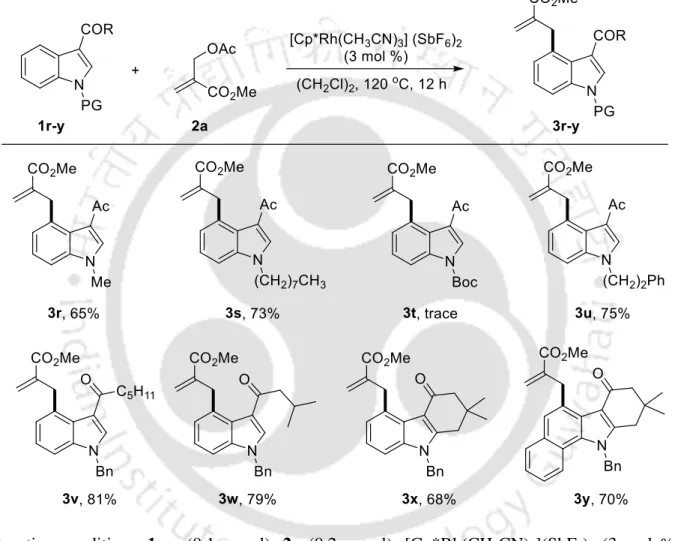
Preliminary Mechanistic Investigations
Later, coordinative double bond insertion of the MBH adduct with intermediate B affords the eight-membered rhodacyclic intermediate D via C. On the other hand, allylation can proceed via oxidative addition of the allylic electrophile, which would generate the -allylrhodium complex Dʹ.18 However, the formation of Dʹ is less popular, as confirmed by the H/D exchange experiment in the presence of 2a. It is evident that the rhodium species with oxidation state +III is involved in the entire catalytic cycle and that the allylation reaction takes place in a redox-neutral version.
To demonstrate the synthetic applicability of the procedure, removal of the acetyl directing group was achieved by a reverse Friedel–Crafts reaction in the presence of TsOH and ethylene glycol, affording 5 in 62% yield ( Scheme 16 ).
Post-Synthetic Utility
- Experimental Section
- References
- Selected NMR Spectra
Drying (Na2SO4) and evaporation of the solvent gave a residue which was purified on silica gel column chromatography using n-hexane and ethyl acetate as an eluent to provide N-protected 3-acetylindoles. The progress of the reaction was monitored by TLC with ethyl acetate and hexane as an eluent. The reaction mixture was then cooled to room temperature, diluted with CH2Cl2 (10 mL) and passed through a short path of celite with CH2Cl2 (2 x 10 mL).
Drying (Na 2 SO 4 ) and evaporating the solvent gave a residue which was purified by silica gel column chromatography using n-hexane and ethyl acetate as eluent to give C4-allylated indoles.
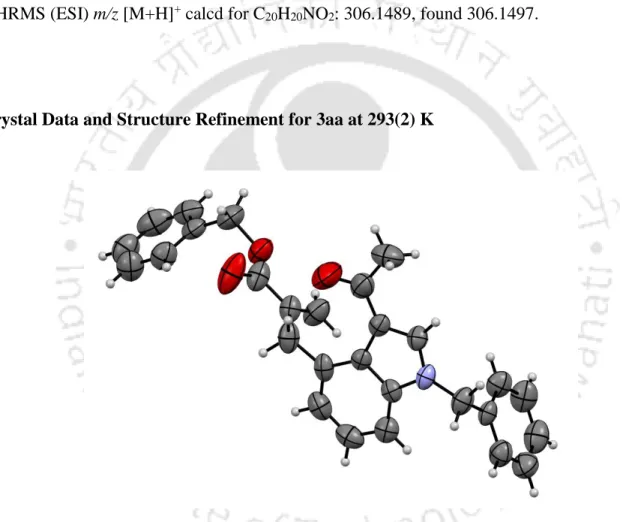
Rh(III)-Catalyzed Switchable C4-Alkenylation and Alkylation of Indoles with Allylic Alcohols
Diverse Reactivity Features of Allylic Alcohols
- Oxidative Alkylation of Arenes with Allylic Alcohols
Glorius and co-workers described an efficient Rh(III)-catalyzed oxidative alkylation of indoles with allylic alcohols as coupling partners using the 2-pyrimidyl directing group (Scheme 2).10 The reaction provides a general route to synthesize various -ketones. aryl and aldehydes. The strategy was further extended to dehydrogenative coupling with several arene systems, such as 2-phenylpyridine, aryl ketones, and acetanilide to afford a class of value-added scaffolds.
Rh(III)-Catalyzed Oxidative C2-Alkylation of Indoles
Oxidative Alkylation of Arenes under Rh(III)-Catalysis
Rh(III)-Catalyzed C7-Alkylation of Indolines
- Oxidative Allylation of Arenes with Allylic Alcohols
Co(III)-Catalyzed Allylation of Heterocycles
Ru(II)-Catalyzed C2-Selective Allylation of Indoles
Matsunaga and Yoshino reported the monoselective allylation of biologically active 6-arylpurine derivatives using allylic alcohols under Co(III) catalysis (Scheme 8).16 A diverse set of functional groups on the aryl ring and substituted benzamides were compatible.
Co(III)-Catalyzed Allylation of 6-Arylpurines
- Switchable Reactivity of Arenes with Allylic alcohols
C8-H Allylation vs Alkylation of Quinolines
Ru(II)-Catalyzed Alkylation vs Alkenylation of Benzoic Acids
- Present Study
The reaction conditions were extended to the coupling of 2j-p substituted allylic alcohols with indole 1a as a standard substrate (Table 4). These results demonstrated the attractive potential of the method for the C4-alkylation of indoles to synthesize -arylated ketones. This shows the tremendous potential of the method for late-stage drug modification and the chemoselectivity can be altered depending on the directing group.20.
While H/D exchange experiments of 1a and 1A independently in the presence or absence of 2a using D2O as a co-solvent revealed significant deuterium incorporation at C4 site (Scheme 12), indicating the reversibility of the CH -indicates activation step.
Control Experiments
H-D Exchange Experiments
Kinetic Isotope Experiment
- Experimental Section
- References
- Selected NMR Spectra
Drying (Na2SO4) and evaporation of the solvent gave a residue which was purified on silica gel. Drying (Na2SO4) and evaporation of the solvent gave a residue which was purified by silica gel column chromatography with n-hexane and ethyl acetate as an eluent to provide C4-alkenylated indoles 3a-z. Drying (Na2SO4) and evaporation of the solvent gave a residue which was purified by silica gel column chromatography.
Drying (Na2SO4) and evaporation of the solvent produced a residue, which was purified on a silica gel column.
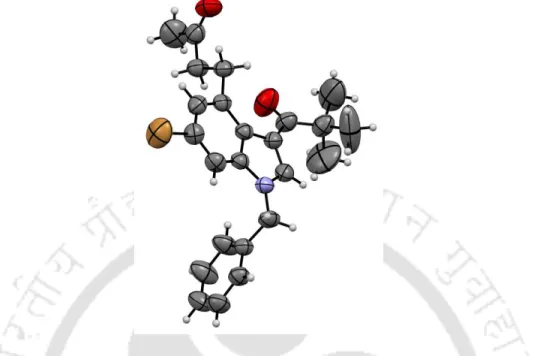
Thesis Overview
In chapter 2, a copper-mediated regioselective C-H/N-H dehydrogenative cross-coupling of 1-naphthyl amides with indoles, pyrazoles and pyrrole was developed using picolamide as a directing group. In Chapter 3, we demonstrated a weak carbonyl coordination that enabled Rh(III)-catalyzed C4-selective redox-neutral allylation of indoles with versatile MBH acetates. In chapter 4, a weak carbonyl coordination directed Rh(III)-catalyzed switchable reactivity between oxidative C4-alkenylation and C4-alkylation of indoles was achieved using allylic alcohols.
2 Direct Redox-Neutral C4 Regional Coupling Driven by Weak Coordination Allylation of Indoles by Morita–Baylis–Hillman Adducts.
Conference Attended
